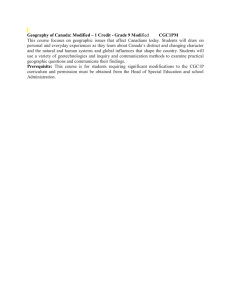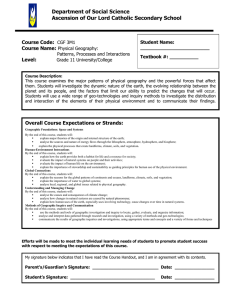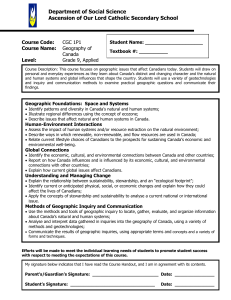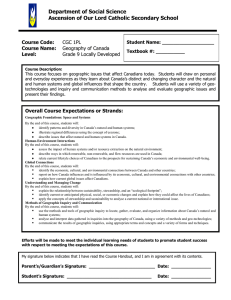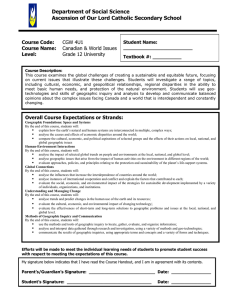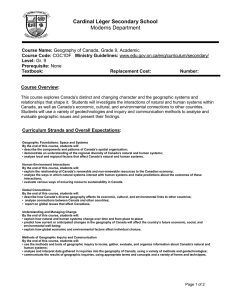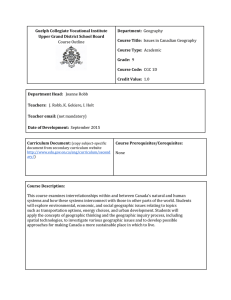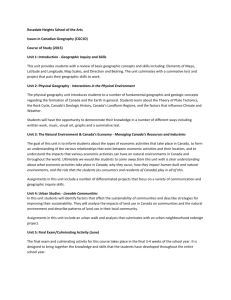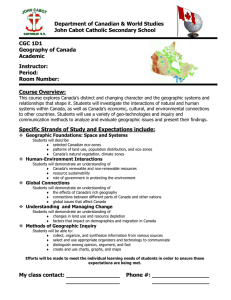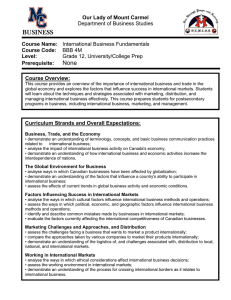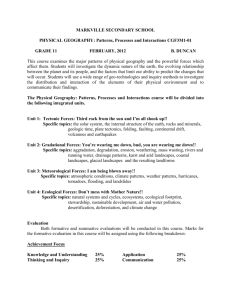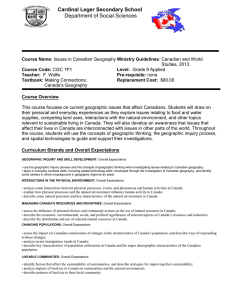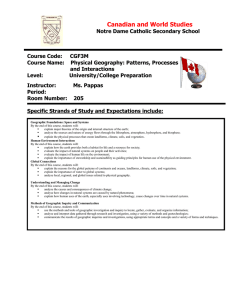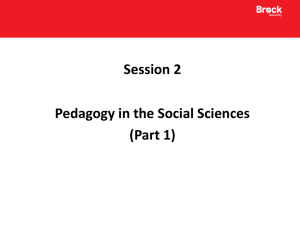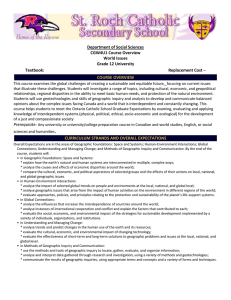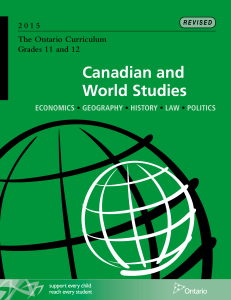Department of Social Science Ascension of Our Lord Catholic Secondary School
advertisement
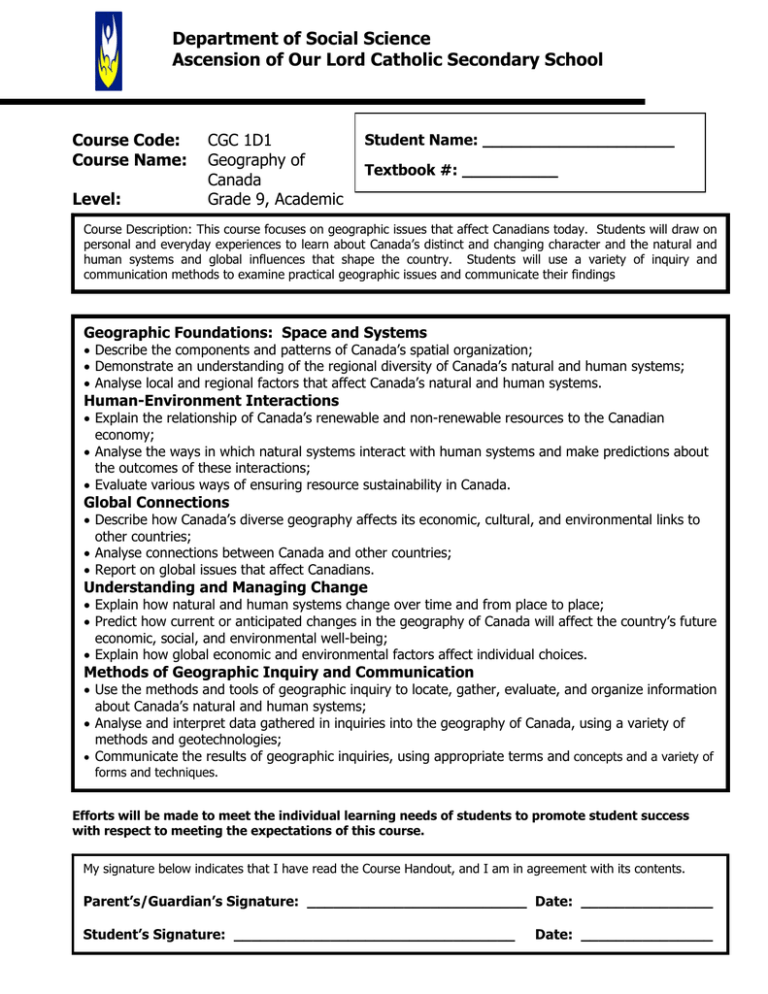
Department of Social Science Ascension of Our Lord Catholic Secondary School Course Code: Course Name: Level: CGC 1D1 Geography of Canada Grade 9, Academic Student Name: ____________________ Textbook #: __________ Course Description: This course focuses on geographic issues that affect Canadians today. Students will draw on personal and everyday experiences to learn about Canada’s distinct and changing character and the natural and human systems and global influences that shape the country. Students will use a variety of inquiry and communication methods to examine practical geographic issues and communicate their findings Geographic Foundations: Space and Systems Describe the components and patterns of Canada’s spatial organization; Demonstrate an understanding of the regional diversity of Canada’s natural and human systems; Analyse local and regional factors that affect Canada’s natural and human systems. Human-Environment Interactions Explain the relationship of Canada’s renewable and non-renewable resources to the Canadian economy; Analyse the ways in which natural systems interact with human systems and make predictions about the outcomes of these interactions; Evaluate various ways of ensuring resource sustainability in Canada. Global Connections Describe how Canada’s diverse geography affects its economic, cultural, and environmental links to other countries; Analyse connections between Canada and other countries; Report on global issues that affect Canadians. Understanding and Managing Change Explain how natural and human systems change over time and from place to place; Predict how current or anticipated changes in the geography of Canada will affect the country’s future economic, social, and environmental well-being; Explain how global economic and environmental factors affect individual choices. Methods of Geographic Inquiry and Communication Use the methods and tools of geographic inquiry to locate, gather, evaluate, and organize information about Canada’s natural and human systems; Analyse and interpret data gathered in inquiries into the geography of Canada, using a variety of methods and geotechnologies; Communicate the results of geographic inquiries, using appropriate terms and concepts and a variety of forms and techniques. Efforts will be made to meet the individual learning needs of students to promote student success with respect to meeting the expectations of this course. My signature below indicates that I have read the Course Handout, and I am in agreement with its contents. Parent’s/Guardian’s Signature: _________________________ Date: _______________ Student’s Signature: ________________________________ Date: _______________ Resources: Course Timeline: The course will use a variety of resources. The primary textbook Making Connections will be distributed to students during the first week of the course. The text and all other resources assigned to each student are the responsibility of the student. Any damage incurred will result in payment for replacement. Canada and the World The Diversity of Canada’s Natural Landscapes Natural Resources: The Challenge of Sustainability People, Places and Patterns Canadian Industry: Location, Impact, Opportunity Unit 1: 22 hours Unit 2: 35 hours Unit 3: 18 hours Unit 4: 18 hours Unit 5: 17 hours Replacement cost for the text is $85.00. Culminating Summative Tasks will be administered towards the end of the course and will be weighted at 30% of the final mark. These tasks are specifically itemized below. All timelines as stated are approximate. Evaluation Policies 1. Student marks will be determined by evaluating process & product according to 4 categories (see below) & 4 levels of the Achievement Chart as found in the Ministry Policy document for Canadian and World Studies. Evaluation Structure: Knowledge/Understanding Application Communication Thinking/Inquiry Term Evaluations = 70% of the final mark. 25% 25% 25% 25% Final Evaluation = 30% of the final mark. Final Evaluations will include: Final Exam = 20%, Culminating Task = 10% 2. Feedback will also be provided for student learning skills. Independent work, collaboration, organization, responsibility, self-regulation and initiative are assessed apart from student achievement in the four categories outlined above and will conform to the coding: E – Excellent G – Good S – Satisfactory N - Needs Improvement 3. Assignments submitted after the due date established by the teacher will receive a penalty in accord with our Board Assessment & Evaluation Policy Document as outlined in the student agenda. 4. Should a student miss an evaluation due to a legitimate absence, in accord with our Board A&E Policy Document, the student and teacher will make arrangements to address the missed evaluation in a timely manner. In the cases of extended vacation or prolonged absence, consultation with the appropriate administrator is required. 5. In the event that the student does not make up the missed evaluation(s), a zero may be assigned. If it is determined that the evaluation(s) has/have been missed as a result of a skip/truancy or has/have been plagiarized, a zero may be assigned. 6. For all other cases of absence and/or missed evaluations (including absence during the final examination period), please refer to our Board A&E Policy as outlined in the student agenda. May God bless your efforts this semester!
